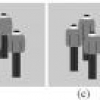Free Online Productivity Tools
i2Speak
i2Symbol
i2OCR
iTex2Img
iWeb2Print
iWeb2Shot
i2Type
iPdf2Split
iPdf2Merge
i2Bopomofo
i2Arabic
i2Style
i2Image
i2PDF
iLatex2Rtf
Sci2ools
ICCV
2007
IEEE
2007
IEEE
Fast Crowd Segmentation Using Shape Indexing
This paper presents a fast, accurate, and novel method for the problem of estimating the number of humans and their positions from background differenced images obtained from a single camera where inter-human occlusion is significant. The problem is challenging firstly because the state space formed by the number, positions, and articulations of people is large. Secondly, in spite of many advances in background maintenance and change detection, background differencing remains a noisy and imprecise process, and its output is far from ideal: holes, fill-ins, irregular boundaries etc. pose additional challenges for our "midlevel" problem of segmenting it to localize humans. We propose a novel example-based algorithm which maps the global shape feature by Fourier descriptors to various configurations of humans directly. We use locally weighted averaging to interpolate for the best possible candidate configuration. The inherent ambiguity resulting from the lack of depth and layer...
Background Difference Images | Background Differenced Images | Computer Vision | Global Shape Feature | ICCV 2007 | Irregular Boundaries Etc | Pose Additional Challenges |
| Added | 14 Oct 2009 |
| Updated | 30 Oct 2009 |
| Type | Conference |
| Year | 2007 |
| Where | ICCV |
| Authors | Lan Dong, Vasu Parameswaran, Visvanathan Ramesh, Imad Zoghlami |
Comments (0)

